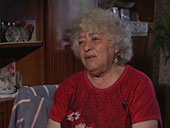
Asya Barshteyn 's father was a purveyor and her mother was a homemaker. She attended a Yiddish school for six years, until her schooling was interrupted by the war. She survived the war in the Sharhorod ghetto. After the war, she completed her schooling by correspondence. She worked as a telegraph dispatcher and a switchboard operator at the post office, and later as a cashier at a barber shop. In 1983 she moved to Vinnytsya,where she is one of the leaders of the Vinnytsya Jewish Women’s Choir.
Other Interviews:
Rebbe, Reb ShneyerThe Great Synagogue
Cantor Gaz
"as though God had baked it"
Home: One Small Room
Vinnytsya, Ukraine
Asya Barshteyn remembers how her father struggled to raise his three daughters well and marry them off adequately. In this clip, she recalls the tiny house they lived in, typical of the time and place.
In part because of their work duties, Jewish women tended to marry later than their non-Jewish neighbors. According to the 1926 census, Jewish men were getting married in their mid-twenties and Jewish women in their early twenties. In Right Bank Ukraine, most Jewish men were married by the age of twenty-five and women by age twenty-two.
Yet, for many women, marriage was not so easy. As a result of the violence that plagued the region - 76 percent of the victims of the pogroms were men —there were 1,140 Jewish women for every 1,000 Jewish men in 1926, and 1,160 Jewish women for every 1,000 Jewish men in 1939.
The marriage market was a competitive one, and many women never married.
Source: Jeffrey Veidlinger, In the Shadow of the Shtetl: Small-Town Jewish Life in Soviet Ukraine (Indiana University Press, 2013)
